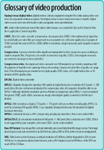Article
How to use videos for patient education and self-assessment
A video format seems to be an acceptable means to respond to patients' dissatisfaction with available information and eagerness for further information.

This article discusses the role of video in both patient education and urologist self-assessment and provides practical advice on how to capture and edit your video clips.
Patient education

The use of video education has been shown in a number of medical settings to improve patient recall of information; eg, explanation of surgical procedures, patient expectations, recovery time, postoperative dietary and activity instructions, etc. Studies have demonstrated that patients will retain only about one-third of the information conveyed to them in the initial consultation due to the high degree of anxiety and distress associated with a diagnosis of a serious disease (Lancet 1999; 354:2032–5; Br J Cancer 1986; 54:319-26).

During the interval between a visit to the doctor and the start of treatment, patients often seek additional information as they become more familiar with their diagnosis (J Cancer Educ 1998; 13:152–61). Patients from ethnic groups are least satisfied with the information they receive and are more likely to actively seek information after they leave the clinic (Eur J Cancer 1996; 33[suppl 8]:1426). Written information is available in many outpatient clinics and hospitals, and on the web sites of national organizations. Presenting the same information about their forthcoming treatment to a patient in a video format has the advantage of providing dynamics (movement and sound) to the written word.

Surgeon self-assessment/training
Since William Stewart Halsted, MD's era, trainees and surgeons have used the operating room as a classroom, watching procedures performed by experienced surgeons. In the past, taking still pictures was possible only under specific conditions, using cumbersome cameras and lenses. As imaging in endoscopic and laparoscopic surgery evolved with digital technology, recording surgical images became a trivial task. Now, not only can a portable phone take pictures, but it also can be used to record a few minutes of any surgical procedure without special lighting. Further, the recording can be transmitted over the Internet to anywhere in the world.





